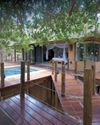
How physically fit do you need to be?
To really embrace the journey and help you complete Hajj safely, preparation is key. Spend as much time on physical preparation as you do on spiritual preparation. The former will support the latter. As soon as you know you are going on Hajj, start spending time on your feet. Being ‘walking fit’ is important. Take the stairs instead of the lift, walk to work – or at least some of the way – and do the school run on foot. But don’t worry; there’s no need to embark on marathon-like training.
What about people with pre-existing medical conditions?
Dr Imran Zia, an emergency medicine consultant from London, who has worked as a Hajj doctor for 11 years and advises for the British Council of Hajj, recommends those with existing health problems carry a document detailing their hospital, consultant, contact information, the name of their conditions, any medication they take, and their medical aid numbers.
Do I need to wear any special clothing?
Having the right footwear for long days, walking in hot, dusty terrain, is essential. Sensible walking shoes with socks are a good place to start. Some people opt for rugged terrain sandals, which also work. The important thing is to buy them in advance and break them in. Don’t wait until you are in Mecca to take them out of the box. You are just inviting blisters!
This story is from the April 2020 edition of Skyways.
Start your 7-day Magzter GOLD free trial to access thousands of curated premium stories, and 8,500+ magazines and newspapers.
Already a subscriber ? Sign In
This story is from the April 2020 edition of Skyways.
Start your 7-day Magzter GOLD free trial to access thousands of curated premium stories, and 8,500+ magazines and newspapers.
Already a subscriber? Sign In

Fit For Purpose
Changing legislation offers a range of opportunities in the health sector

Good For Grinches
Finally! A holiday season Scrooge himself can invest in

A Paradise In The Wilderness
Visitors find freedom at Treedom on the Garden Route

Do It For The Kids
Parenting styles play an important role in helping children develop through the pandemic and beyond

Trekking With Teens
Travelling with adolescents comes with a unique set of challenges

Know Your Mind
Our brain uses shortcuts to think quickly but, sometimes, these mental timesavers let us down. Dr Pragya Agarwal discusses the science of cognitive biases, and why it’s more important than ever to understand how they hold sway over our views

Infected With The Travel Bug Again
As tourism-related establishments up their game to ensure visitor health and safety, it’s possible to feel positive about travelling again

Star attraction
Greater Kruger lodge makes a spectacular first impression

Palala position
The effect of the past on the present is positively felt in a luxury Waterberg lodge

Can the spam!
Irrelevant advertising will almost certainly turn consumers against your product